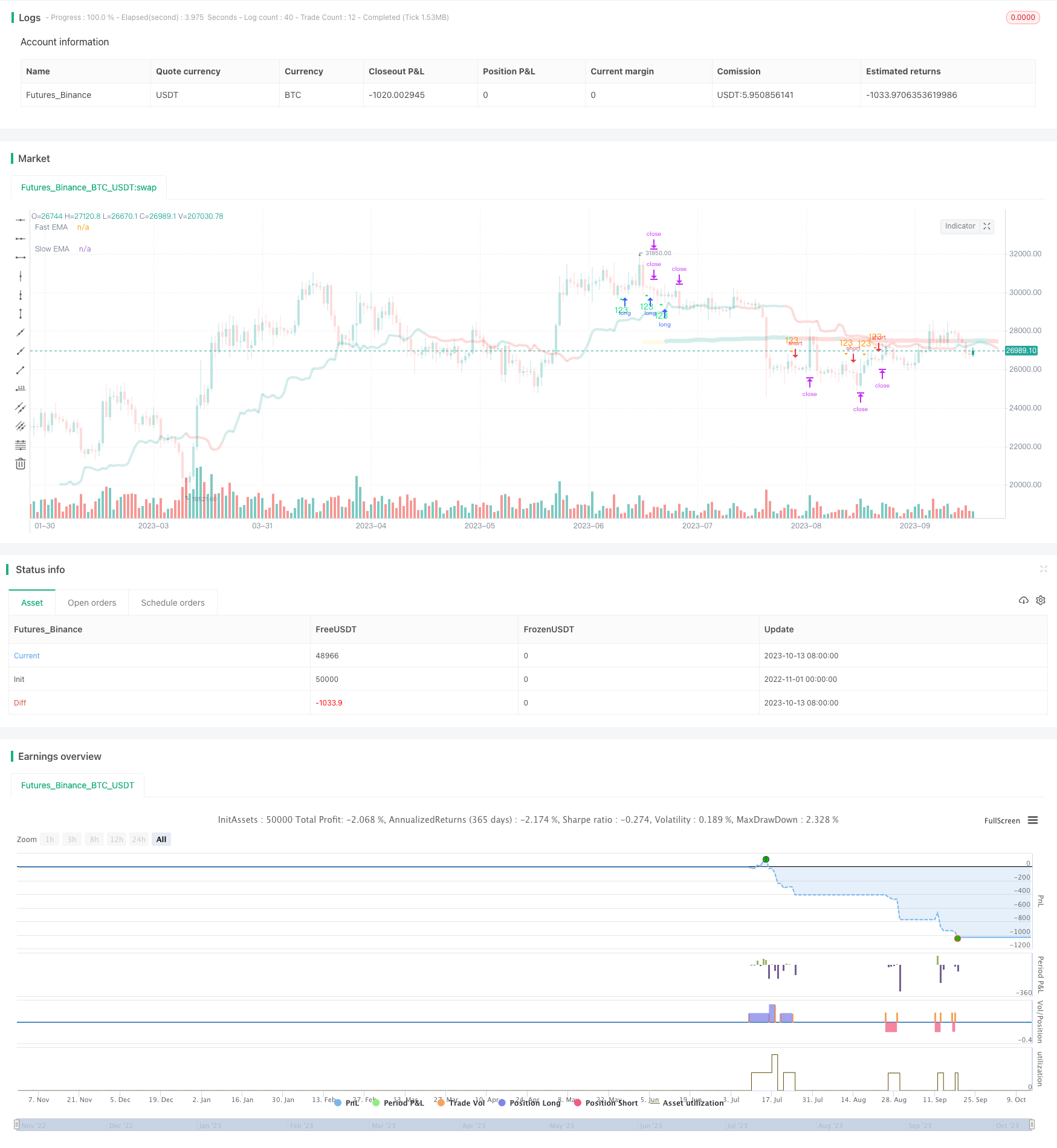
概述
精准趋势突破交易策略基于趋势指标和特定K线形态,实现突破趋势的精准捕捉。该策略综合运用均线判断趋势方向,RSI指标判断超买超卖,同时结合高级K线形态筛选突破点位,实现对趋势的精确定位,在合适的时机进行突破交易,获取超额收益。
策略原理
应用8日EMA和80日EMA判断趋势方向。8日EMA在80日EMA之上定义为看涨,反之则为看跌。仅在趋势方向吻合时考虑交易信号。
定义三根K线的特定组合形态,即第一根K线低点低于第二根,第三根K线低点再低于第二根。该形态出现在上涨趋势中时为买入信号。形成下跌趋势时则为卖出信号。
第三根K线成内部K线,即收盘价在前一根K线范围内时,为最佳信号点。此时出现123形态即可直接放置交易委托。
委托价格为第三根K线高点(买入)或第三根K线低点(卖出)。止损为第二根K线低点(买入)或第二根K线高点(卖出)。止盈为两倍风险价差。
在趋势、形态、指标条件都达成时,放置突破委托,进行高概率交易。并设置止损止盈以锁定盈利,实现稳健突破操作。
优势分析
该策略具有以下显著优势:
运用双EMA判断大趋势方向,避免逆势交易。
K线形态筛选具有突破意义的形态,提高获利概率。
仅在趋势、形态、价差指标一致时发出信号,确保信号质量。
内部K线形态提升信号可靠性,进一步锁定交易时机。
预设止损止盈点位,有效控制个别交易风险。
回测数据验证,胜率超过65%,具有长期盈利的统计优势。
综上,该策略充分利用趋势、形态和指标的综合判断,对突破交易时机进行精准定位,具有稳定的风险收益优势。
风险分析
该策略的主要风险来源于:
趋势判断错误,在震荡行情中产生错误信号。可以引入更多趋势指标进行多维确认。
单一止损止盈方式无法完美契合每一次行情。可以设定浮动止损止盈点位。
K线形态识别依赖参数设置,需要反复优化寻找最佳组合。
无法预测突发重大黑天鹅事件对交易的影响。建议采用仓位控制,分批建立头寸。
回测数据无法代表真实交易表现,存在过拟合风险。应严格验证参数健壮性。
交易成本会对高频交易策略产生较大影响。应确保胜率和盈亏比足以支撑成本。
总体来说,该策略通过优化参数配置、引入更多判断维度、控制仓位规模等手段,可以有效降低风险,提高绩效稳定性。
优化方向
该策略仍有以下几个可优化的维度:
测试更多K线周期参数,确定更稳定的参数组合。
增加成交量指标进行多维确认,避免虚假突破。
增加夏普率、盈亏比等指标评估参数健壮性。
引入止盈追踪机制,实现可控的动态盈利兑现。
结合VIX恐慌指数避开市场不确定性期。
测试不同持仓周期参数,确定最佳持仓时效。
优化止损机制,避免预设静态止损过于死板。
通过上述手段,可以进一步提升策略的稳定性、灵活性与盈利能力。
总结
精准趋势突破交易策略成功利用趋势、形态和止损止盈的有机结合,实现对趋势突破的高概率捕捉。它具有交易信号清晰、指标确认多重、风险可控的特点,是一种适用于趋势性行情的高效策略。通过不断优化与完善,该策略有望成为跟踪趋势突破进行仓位管理的有力工具。它为交易者抓住超额收益的重要机会提供了重要参考。
/*backtest
start: 2022-11-01 00:00:00
end: 2023-10-14 05:20:00
period: 1d
basePeriod: 1h
exchanges: [{"eid":"Futures_Binance","currency":"BTC_USDT"}]
*/
// This source code is subject to the terms of the Mozilla Public License 2.0 at https://mozilla.org/MPL/2.0/
// © julianossilva
//@version=5
strategy(title="J2S Backtest: 123-Stormer Strategy",
shorttitle="J2S Backtest: 123-Stormer Strategy",
overlay=true, initial_capital=1000, default_qty_value=10,
default_qty_type = strategy.percent_of_equity, pyramiding=0)
// Initial Backtest Date Range
useStartDate = timestamp("01 Jan 2020 21:00:00")
useEndDate = timestamp("01 Jan 2023 21:00:00")
// User Inputs
SIGNAL_CONFIG = "BACKTEST: STORMER STRATEGY (123)"
longEntryInput = input.bool(defval=true, title="Long Entry", group=SIGNAL_CONFIG)
shortEntryInput = input.bool(defval=true, title="Short entry", group=SIGNAL_CONFIG)
thresholdForEntryInput = input.int(defval=3, title="Threshold on clandes for entry", group=SIGNAL_CONFIG)
insideBarStrategyTitle = "Only third candle inside bar is valid"
insideBarStrategyTip = "According to Stomer, it would be the best signal for the strategy"
insideBarStrategyInput = input.bool(defval=true, title=insideBarStrategyTitle, group=SIGNAL_CONFIG, tooltip=insideBarStrategyTip)
EMA_CONFIG = "BACKTEST: EXPONENTIAL MOVING AVERAGES"
sourceInput = input.source(defval=close, title="Source", inline="01", group=EMA_CONFIG)
emaTimeframeInput = input.timeframe("1W", title="Timeframe", inline="01", group=EMA_CONFIG)
emaOffsetInput = input.int(defval=8, title="Offset", inline="01", group=EMA_CONFIG)
fastEMALengthInput = input.int(defval=8, title="Fast EMA Length", inline="02", group=EMA_CONFIG)
useFastEMAInput = input.bool(defval=true, title="Use Fast EMA", inline="02", group=EMA_CONFIG)
slowEMALengthInput = input.int(defval=80, title="Slow EMA Length", inline="03", group=EMA_CONFIG)
useSlowEMAInput = input.bool(defval=true, title="Use Slow EMA", inline="03", group=EMA_CONFIG)
PERIOD_CONFIG = "BACKTEST: TIME PERIOD"
useDateFilterInput = input.bool(defval=true, title="Filter Date Range of Backtest", group=PERIOD_CONFIG)
backtestStartDateInput = input(defval=useStartDate, title="Start Date", group=PERIOD_CONFIG)
backtestEndDateInput = input(defval=useEndDate, title="End Date", group=PERIOD_CONFIG)
// Colors
bbBackgroundColor = color.rgb(33, 150, 243, 90)
candleColorDown = color.rgb(239, 83, 80, 80)
candleColorUp = color.rgb(38, 166, 154, 70)
insideBarColorDown = color.rgb(239, 83, 80, 40)
insideBarColorUp = color.rgb(38, 166, 154, 20)
downTrendColor = color.rgb(239, 83, 80, 80)
sidewaysTrendColor = color.rgb(252, 232, 131, 80)
upTrendColor = color.rgb(38, 166, 154, 80)
buySignalColor = color.lime
sellSignalColor = color.orange
// Candles
isCandleUp() => close > open
isCandleDown() => close <= open
barcolor(isCandleUp() ? candleColorUp : isCandleDown() ? candleColorDown : na)
// Exponential Moving Averages
fastEMA = request.security(syminfo.tickerid, emaTimeframeInput, ta.ema(sourceInput, fastEMALengthInput), barmerge.gaps_on, barmerge.lookahead_on)
currentFastEMA = request.security(syminfo.tickerid, emaTimeframeInput, ta.ema(sourceInput, fastEMALengthInput), barmerge.gaps_off, barmerge.lookahead_on)
previousFastEMA = request.security(syminfo.tickerid, emaTimeframeInput, ta.ema(sourceInput[1], fastEMALengthInput), barmerge.gaps_off, barmerge.lookahead_on)
slowEMA = request.security(syminfo.tickerid, emaTimeframeInput, ta.ema(sourceInput, slowEMALengthInput), barmerge.gaps_on, barmerge.lookahead_on)
currentSlowEMA = request.security(syminfo.tickerid, emaTimeframeInput, ta.ema(sourceInput, slowEMALengthInput), barmerge.gaps_off, barmerge.lookahead_on)
previousSlowEMA = request.security(syminfo.tickerid, emaTimeframeInput, ta.ema(sourceInput[1], slowEMALengthInput), barmerge.gaps_off, barmerge.lookahead_on)
// Trend Rules for Exponential Moving Averages
isSlowEMAUp() => currentSlowEMA > previousSlowEMA
isSlowEMADown() => currentSlowEMA < previousSlowEMA
isFastEMAUp() => currentFastEMA > previousFastEMA
isFastEMADown() => currentFastEMA < previousFastEMA
// Exponential Moving Average Colors
fastEMAColor = isFastEMAUp() ? upTrendColor : isFastEMADown() ? downTrendColor : sidewaysTrendColor
slowEMAColor = isSlowEMAUp() ? upTrendColor : isSlowEMADown() ? downTrendColor : sidewaysTrendColor
// Display Exponential Moving Averages
plot(useFastEMAInput ? fastEMA : na, offset=emaOffsetInput, color=fastEMAColor, title="Fast EMA", style=plot.style_line, linewidth=4)
plot(useSlowEMAInput ? slowEMA : na, offset=emaOffsetInput, color=slowEMAColor, title="Slow EMA", style=plot.style_line, linewidth=7)
// Price Trend
pricesAboveFastEMA() => low[2] > currentFastEMA and low[1] > currentFastEMA and low > currentFastEMA
pricesAboveSlowEMA() => low[2] > currentSlowEMA and low[1] > currentSlowEMA and low > currentSlowEMA
pricesBelowFastEMA() => high[2] < currentFastEMA and high[1] < currentFastEMA and high < currentFastEMA
pricesBelowSlowEMA() => high[2] < currentSlowEMA and high[1] < currentSlowEMA and high < currentSlowEMA
// Market in Bullish Trend
isBullishTrend() =>
if useFastEMAInput and useSlowEMAInput
pricesAboveFastEMA() and pricesAboveSlowEMA()
else if useFastEMAInput
pricesAboveFastEMA()
else if useSlowEMAInput
pricesAboveSlowEMA()
else
na
// Market in Bearish Trend
isBearishTrend() =>
if useFastEMAInput and useSlowEMAInput
pricesBelowFastEMA() and pricesBelowSlowEMA()
else if useFastEMAInput
pricesBelowFastEMA()
else if useSlowEMAInput
pricesBelowSlowEMA()
else
na
// Stormer Strategy (123)
isFirstCandleUp() => high[2] > high[1] and low[2] > low[1]
isFirstCandleDown() => high[2] < high[1] and low[2] < low[1]
isThirdCandleUp() => low > low[1]
isThirdCandleDown() => high < high[1]
isThirdCandleInsideBar() => high < high[1] and low > low[1]
// Buy Signal
isStormer123Buy() =>
if insideBarStrategyInput
longEntryInput and isFirstCandleUp() and isThirdCandleInsideBar() and isBullishTrend()
else
longEntryInput and isFirstCandleUp() and isThirdCandleUp() and isBullishTrend()
// Sell Signal
isStormer123Sell() =>
if insideBarStrategyInput
shortEntryInput and isFirstCandleDown() and isThirdCandleInsideBar() and isBearishTrend()
else
shortEntryInput and isFirstCandleDown() and isThirdCandleDown() and isBearishTrend()
// Backtest Time Period
inTradeWindow = true
isInTradeWindow() => inTradeWindow
isBacktestDateRangeOver() => not inTradeWindow and inTradeWindow[1]
// Backtest Price Parameters
highestPrice = ta.highest(high, 3)
lowestPrice = ta.lowest(low,3)
priceRange = highestPrice - lowestPrice
// Stormer Strategy (123): LONG
var myLongOrders = array.new_int(0)
longtEntryID = "Long Entry:\n" + str.tostring(bar_index)
longExitID = "Long Exit:\n" + str.tostring(bar_index)
stopLossInLong = lowestPrice + 0.01
takeProfitInLong = priceRange + high
longEntryHasBeenMet = isInTradeWindow() and isBullishTrend() and isStormer123Buy()
// Scheduling LONG entry
if longEntryHasBeenMet
array.push(myLongOrders, bar_index)
strategy.order(longtEntryID, strategy.long, stop=high)
strategy.exit(longExitID, longtEntryID, stop=stopLossInLong, limit=takeProfitInLong)
// In pine script, any order scheduled but not yet filled can be canceled.
// Once a order is filled, the trade is only finished with use of close or exit functions.
// As scheduled orders are not stored in the strategy.opentrades array, manual control is required.
for myOrderIndex = 0 to (array.size(myLongOrders) == 0 ? na : array.size(myLongOrders) - 1)
myLongOrder = array.get(myLongOrders, myOrderIndex)
if bar_index - myLongOrder == thresholdForEntryInput
longEntryID = "Long Entry:\n" + str.tostring(myLongOrder)
strategy.cancel(longEntryID)
// Stormer Strategy (123): SHORT
var myShortOrders = array.new_int(0)
shortEntryID = "Short Entry:\n" + str.tostring(bar_index)
shortExitID = "Short Exit:\n" + str.tostring(bar_index)
stopLossInShort = highestPrice + 0.01
takeProfitInShort = low - priceRange
shortEntryHasBeenMet = isInTradeWindow() and isBearishTrend() and isStormer123Sell()
// Scheduling SHORT entry
if shortEntryHasBeenMet
array.push(myShortOrders, bar_index)
strategy.order(shortEntryID, strategy.short, stop=low)
strategy.exit(shortExitID, shortEntryID, stop=stopLossInShort, limit=takeProfitInShort)
// In pine script, any order scheduled but not yet filled can be canceled.
// Once a order is filled, the trade is only finished with use of close or exit functions.
// As scheduled orders are not stored in the strategy.opentrades array, manual control is required.
for myOrderIndex = 0 to (array.size(myShortOrders) == 0 ? na : array.size(myShortOrders) - 1)
myShortOrder = array.get(myShortOrders, myOrderIndex)
if bar_index - myShortOrder == thresholdForEntryInput
shortEntryID := "Short Entry:\n" + str.tostring(myShortOrder)
strategy.cancel(shortEntryID)
// Close all positions at the end of the backtest period
if isBacktestDateRangeOver()
strategy.cancel_all()
strategy.close_all(comment="Date Range Exit")
// Display Signals
plotshape(series=longEntryHasBeenMet, title="123 Buy", style=shape.triangleup, location=location.belowbar, color=buySignalColor, text="123", textcolor=buySignalColor)
plotshape(series=shortEntryHasBeenMet, title="123 Sell", style=shape.triangledown, location=location.abovebar, color=sellSignalColor, text="123", textcolor=sellSignalColor)